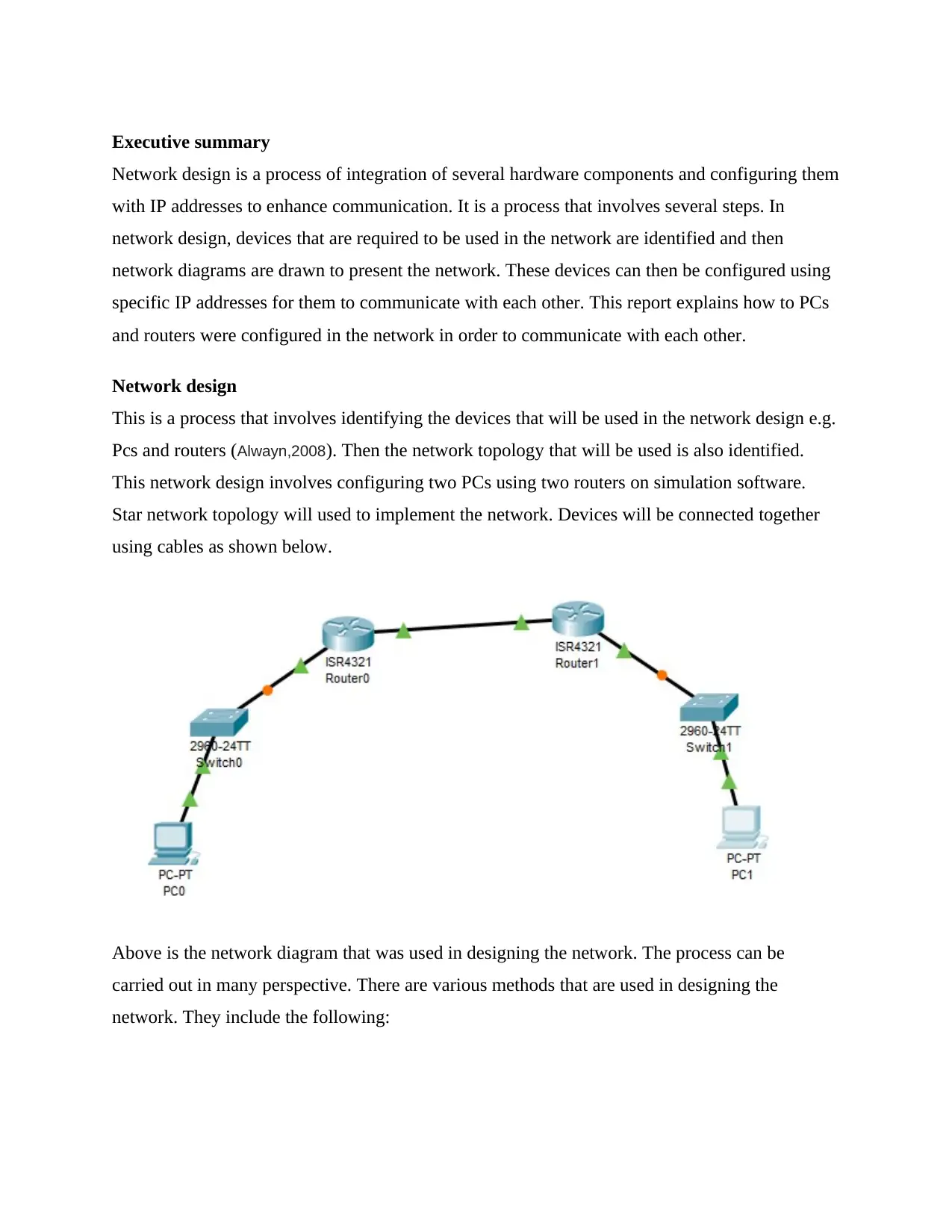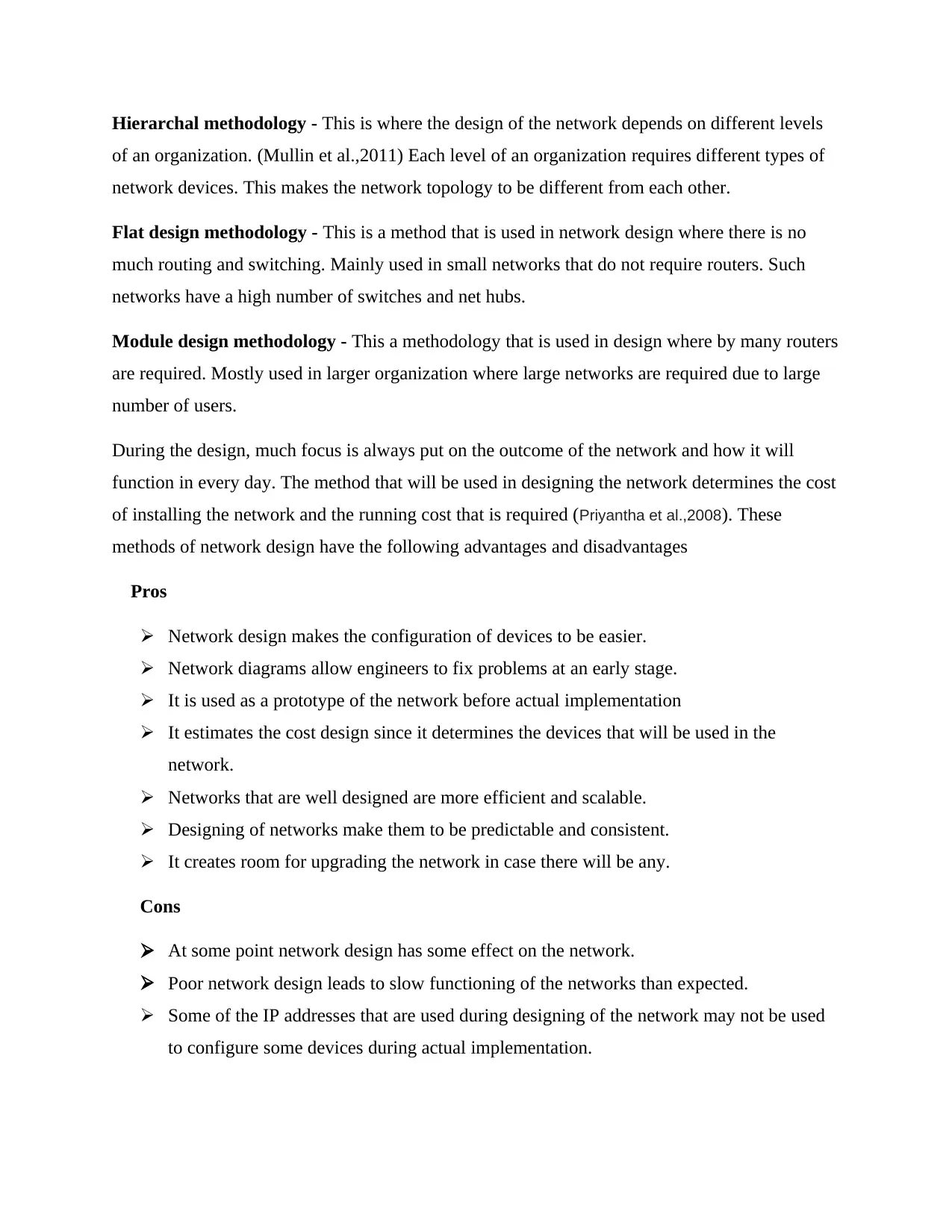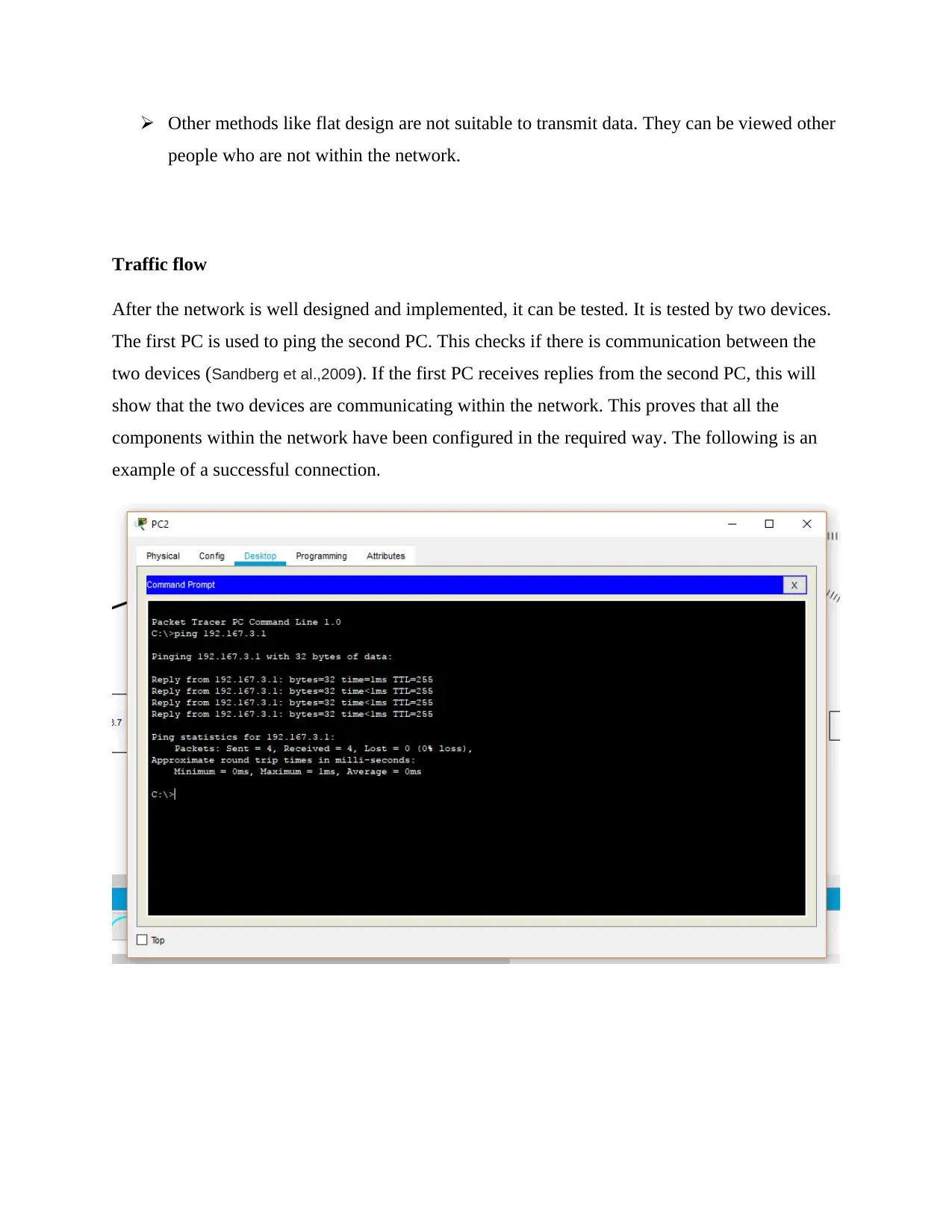Network Design: Implementation & Configuration of PCs and Routers
VerifiedAdded on 2023/06/07
|5
|860
|140
Report
AI Summary
This report provides an overview of network design, focusing on the configuration of PCs and routers within a simulated environment. It highlights the importance of network design in integrating hardware components and configuring IP addresses to facilitate communication. The report discusses different network design methodologies, including hierarchical, flat, and modular designs, outlining their respective advantages and disadvantages. It also addresses the significance of traffic flow testing to ensure proper network functionality. The document includes a network diagram illustrating the connections between devices and concludes with references to relevant literature on network design and implementation. Desklib offers this document as a study resource, along with many other solved assignments and past papers.

NETWORK DESIGN
Paraphrase This Document
Need a fresh take? Get an instant paraphrase of this document with our AI Paraphraser

Executive summary
Network design is a process of integration of several hardware components and configuring them
with IP addresses to enhance communication. It is a process that involves several steps. In
network design, devices that are required to be used in the network are identified and then
network diagrams are drawn to present the network. These devices can then be configured using
specific IP addresses for them to communicate with each other. This report explains how to PCs
and routers were configured in the network in order to communicate with each other.
Network design
This is a process that involves identifying the devices that will be used in the network design e.g.
Pcs and routers (Alwayn,2008). Then the network topology that will be used is also identified.
This network design involves configuring two PCs using two routers on simulation software.
Star network topology will used to implement the network. Devices will be connected together
using cables as shown below.
Above is the network diagram that was used in designing the network. The process can be
carried out in many perspective. There are various methods that are used in designing the
network. They include the following:
Network design is a process of integration of several hardware components and configuring them
with IP addresses to enhance communication. It is a process that involves several steps. In
network design, devices that are required to be used in the network are identified and then
network diagrams are drawn to present the network. These devices can then be configured using
specific IP addresses for them to communicate with each other. This report explains how to PCs
and routers were configured in the network in order to communicate with each other.
Network design
This is a process that involves identifying the devices that will be used in the network design e.g.
Pcs and routers (Alwayn,2008). Then the network topology that will be used is also identified.
This network design involves configuring two PCs using two routers on simulation software.
Star network topology will used to implement the network. Devices will be connected together
using cables as shown below.
Above is the network diagram that was used in designing the network. The process can be
carried out in many perspective. There are various methods that are used in designing the
network. They include the following:

Hierarchal methodology - This is where the design of the network depends on different levels
of an organization. (Mullin et al.,2011) Each level of an organization requires different types of
network devices. This makes the network topology to be different from each other.
Flat design methodology - This is a method that is used in network design where there is no
much routing and switching. Mainly used in small networks that do not require routers. Such
networks have a high number of switches and net hubs.
Module design methodology - This a methodology that is used in design where by many routers
are required. Mostly used in larger organization where large networks are required due to large
number of users.
During the design, much focus is always put on the outcome of the network and how it will
function in every day. The method that will be used in designing the network determines the cost
of installing the network and the running cost that is required (Priyantha et al.,2008). These
methods of network design have the following advantages and disadvantages
Pros
Network design makes the configuration of devices to be easier.
Network diagrams allow engineers to fix problems at an early stage.
It is used as a prototype of the network before actual implementation
It estimates the cost design since it determines the devices that will be used in the
network.
Networks that are well designed are more efficient and scalable.
Designing of networks make them to be predictable and consistent.
It creates room for upgrading the network in case there will be any.
Cons
At some point network design has some effect on the network.
Poor network design leads to slow functioning of the networks than expected.
Some of the IP addresses that are used during designing of the network may not be used
to configure some devices during actual implementation.
of an organization. (Mullin et al.,2011) Each level of an organization requires different types of
network devices. This makes the network topology to be different from each other.
Flat design methodology - This is a method that is used in network design where there is no
much routing and switching. Mainly used in small networks that do not require routers. Such
networks have a high number of switches and net hubs.
Module design methodology - This a methodology that is used in design where by many routers
are required. Mostly used in larger organization where large networks are required due to large
number of users.
During the design, much focus is always put on the outcome of the network and how it will
function in every day. The method that will be used in designing the network determines the cost
of installing the network and the running cost that is required (Priyantha et al.,2008). These
methods of network design have the following advantages and disadvantages
Pros
Network design makes the configuration of devices to be easier.
Network diagrams allow engineers to fix problems at an early stage.
It is used as a prototype of the network before actual implementation
It estimates the cost design since it determines the devices that will be used in the
network.
Networks that are well designed are more efficient and scalable.
Designing of networks make them to be predictable and consistent.
It creates room for upgrading the network in case there will be any.
Cons
At some point network design has some effect on the network.
Poor network design leads to slow functioning of the networks than expected.
Some of the IP addresses that are used during designing of the network may not be used
to configure some devices during actual implementation.
⊘ This is a preview!⊘
Do you want full access?
Subscribe today to unlock all pages.

Trusted by 1+ million students worldwide

Other methods like flat design are not suitable to transmit data. They can be viewed other
people who are not within the network.
Traffic flow
After the network is well designed and implemented, it can be tested. It is tested by two devices.
The first PC is used to ping the second PC. This checks if there is communication between the
two devices (Sandberg et al.,2009). If the first PC receives replies from the second PC, this will
show that the two devices are communicating within the network. This proves that all the
components within the network have been configured in the required way. The following is an
example of a successful connection.
people who are not within the network.
Traffic flow
After the network is well designed and implemented, it can be tested. It is tested by two devices.
The first PC is used to ping the second PC. This checks if there is communication between the
two devices (Sandberg et al.,2009). If the first PC receives replies from the second PC, this will
show that the two devices are communicating within the network. This proves that all the
components within the network have been configured in the required way. The following is an
example of a successful connection.
Paraphrase This Document
Need a fresh take? Get an instant paraphrase of this document with our AI Paraphraser

References
Alwayn, V. (2008). Optical network design and implementation. Cisco Press.
Mullins, R., West, A., & Moore, S. (2011, January). The design and implementation of a low-latency on-
chip network. In Proceedings of the 2006 Asia and South Pacific Design Automation
Conference (pp. 164-169). IEEE Press.
Priyantha, N. B., Kansal, A., Goraczko, M., & Zhao, F. (2008, November). Tiny web services: design and
implementation of interoperable and evolvable sensor networks. In Proceedings of the 6th ACM
conference on Embedded network sensor systems (pp. 253-266). ACM.
Sandberg, R., Goldberg, D., Kleiman, S., Walsh, D., & Lyon, B. (2009, June). Design and
Implementation of the Sun network filesystem. In Proceedings of the Summer USENIX
conference (pp. 119-130).
Alwayn, V. (2008). Optical network design and implementation. Cisco Press.
Mullins, R., West, A., & Moore, S. (2011, January). The design and implementation of a low-latency on-
chip network. In Proceedings of the 2006 Asia and South Pacific Design Automation
Conference (pp. 164-169). IEEE Press.
Priyantha, N. B., Kansal, A., Goraczko, M., & Zhao, F. (2008, November). Tiny web services: design and
implementation of interoperable and evolvable sensor networks. In Proceedings of the 6th ACM
conference on Embedded network sensor systems (pp. 253-266). ACM.
Sandberg, R., Goldberg, D., Kleiman, S., Walsh, D., & Lyon, B. (2009, June). Design and
Implementation of the Sun network filesystem. In Proceedings of the Summer USENIX
conference (pp. 119-130).
1 out of 5
Related Documents
Your All-in-One AI-Powered Toolkit for Academic Success.
+13062052269
info@desklib.com
Available 24*7 on WhatsApp / Email
![[object Object]](/_next/static/media/star-bottom.7253800d.svg)
Unlock your academic potential
Copyright © 2020–2025 A2Z Services. All Rights Reserved. Developed and managed by ZUCOL.




